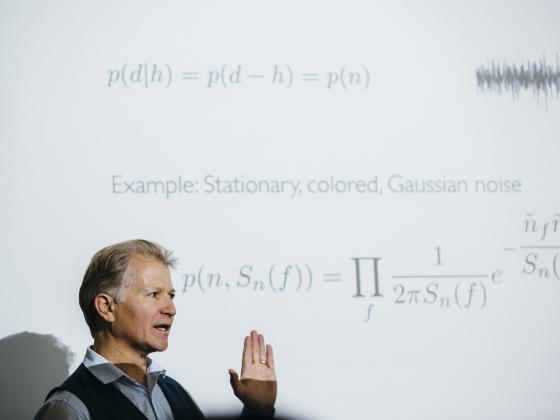BOZEMAN – Almost 100 years after Albert Einstein predicted the existence of disturbances in space-time known as gravitational waves, scientists first detected such ripples with ground-based instruments on Sept. 14, 2015.
Nearly eight years later, in June 2023, astrophysicists published evidence of very low-frequency gravitational waves observed in the timing of signals emitted by distant pulsars located thousands of light years from one another.
Montana State University Regents Professor Neil Cornish, director of MSU’s eXtreme Gravity Institute in the Department of Physics in the College of Letters and Science, was involved in both projects, and for the past quarter century, he has been part of another that promises to be just as significant: developing a space-based gravitational wave detector called the Laser Interferometer Space Antenna, or LISA, a project led by the European Space Agency in collaboration with NASA.
This week, NASA appointed Cornish and five other U.S. scientists to the science advisory team for the multi-billion-dollar international mission, which is expected to begin in the mid-2030s. The agencies plan to launch three spacecraft that will be the points of an equilateral triangle, 1.6 million miles long on each side, that will follow Earth in its orbit around the sun. The three spacecraft will fire lasers continually between one another, creating beams that will be measurably disturbed by gravitational waves rippling across the fabric of space.
As LISA’s space-bound components are built over the next decade, the science advisory team will work closely with engineers to ensure the scientific integrity of the mission. Joey Shapiro Key, a former student of Cornish’s who is now an associate professor at the University of Washington, also has been named to the team.
“The people on the science team have a mixture of skills,” said Cornish, adding that it was members of his MSU research group – including Key – who pioneered the technique to extract data from gravitational wave signals to determine their sources. “That’s one reason there are two of us from Montana State on the science advisory team. That’s our expertise.”
Gravitational waves are created by such cosmic events as the mergers of black holes or neutron stars. The waves detected by the Laser Interferometer Gravitational Wave Observatory (LIGO) on Earth in 2015 were generated by the merger of two massive black holes located 1.3 billion light years away. That event generated high-frequency ripples small enough to be picked up by LIGO.
By contrast, the signatures detected via the timing of pulsar emissions — work accomplished by the North American Nanohertz Observatory for Gravitational Waves (NANOGrav) — are from very low-frequency gravitational waves that oscillate with periods of years to decades. They are undetectable with a ground-based system, which cannot measure waves larger than the Earth.
The high-precision LISA antenna will detect gravitational waves in a range between the two, with wavelengths between 18 billion miles and 1.8 million miles. Cornish believes the new capability could unfold an entirely new branch of astronomy.
“This is opening up an entire range of the spectrum where we expect there are vast numbers of gravitational waves,” he said. “I’m very hopeful that this detector, with its incredible sensitivity, will lead us to discover phenomena in the universe that we haven’t even conceived of.”
It’s been 50 years since the idea for a space-based gravitational wave detector was proposed by a group of eminent astronomers, all of whom Cornish worked with over the years as a member of the LISA science team.
“I’ve been thinking about this mission since 1999, and three of my current students at MSU are working on this project,” he said. “We’re picking up the torch and carrying it, hoping we can bring this to a successful end for the beginning of this branch of science.”
Cornish said the data collected by LISA should allow scientists to map the structures of black holes in exquisite detail and enable the detection of gravitational waves spawned by types of events that haven’t been previously encountered.
“But for me, the most exciting thing is the chance of discovering something completely unexpected. What haven’t we thought of? What surprises does the universe have that we might find with this detector?
“It’s a chance to discover something completely new about the universe,” he said.




